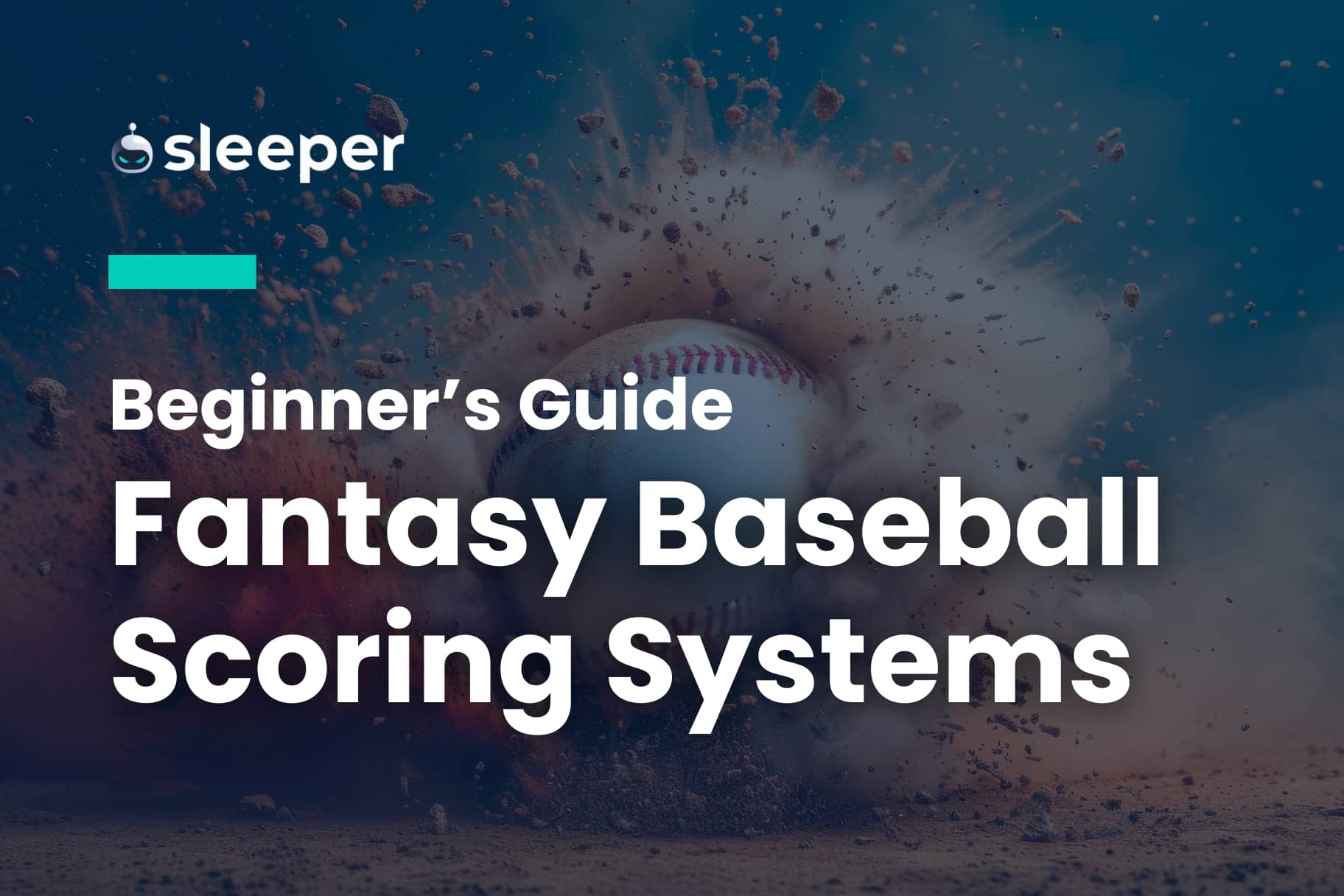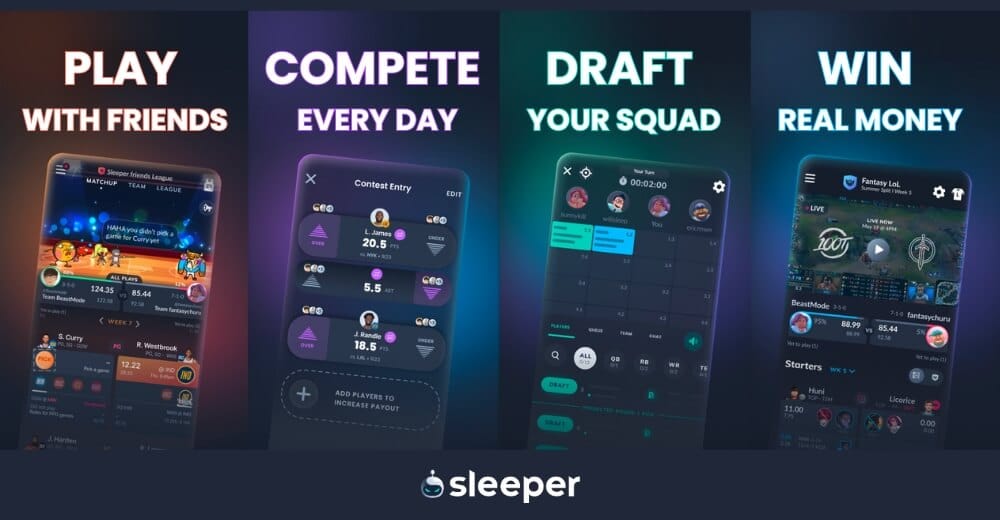There are numerous scoring systems and categories for fantasy baseball, but it’s nowhere near as complex as it might seem.

Fantasy baseball can be more fun than a barrel of monkeys, but the scoring for it could leave a beginner more confused than a chameleon in a bag of skittles.
Obviously, home runs are good for hitters and bad for pitchers. But how does everything that happens on the MLB diamond add up to a win or a loss in fantasy baseball?
Allow us to walk you through the various scoring systems and the standard categories used for determining a champion.
Types of Fantasy Baseball Scoring Systems
Head-to-Head (H2H) Points
If you’ve played conventional fantasy football — where the goal is to outscore a specific opponent that changes on a weekly basis — H2H Points is the same idea.
We’ll take a deeper look later at how points are calculated. For one example, though, if a batter in your active lineup hits a two-run home run, you would (in a standard points league) gain seven points: one for the run scored, two for the two runs batted in (RBI) and four for the total bases.
The player with the most points at the end of the week wins the matchup.
Lather, rinse, repeat for six months until a league champion is crowned.
Head-to-Head (H2H) Categories
In H2H Points, you can win on a regular basis by just loading up on sluggers. In H2H Categories, however, you need a more diverse portfolio.
You’re still facing a specific opponent, but you’re trying to win the most categories as opposed to accumulating the most points. If your team steals 20 bases for the week while your opponent’s team only swipes three, that’s neat. However, it’s only one category, and the margin of victory within each category doesn’t matter. (We’ll get into the various categories shortly.)
In “most categories” leagues, the overall margin doesn’t matter, either. Whether it’s 9-1 or 5-4-1 (five wins, four losses and a draw), a win is a win and a loss is a loss. In “each category” leagues, though, each category counts toward your record. So, instead of having a 12-9-1 record at the end of a 22-week season, it’ll look more like 124-82-14.
Rotisserie (Roto)
Like the cooking style of the same name, rotisserie — the original form of fantasy baseball that started in 1980 — is a slow burn. It’s also nothing like what you’re used to seeing in fantasy football.
It’s similar to H2H Categories in that you need to diversify to contend in as many categories as possible. Instead of facing a specific opponent, though, you’re sort of battling the entire league on a daily basis.
At the end of the season, final standings are based on the rankings in each category. If it’s a 10-team league, finishing in first place in a category (home runs, saves, etc.) is worth 10 points, second place is worth nine points, and so on.
Sum up those points for each of the categories and the person with the most total points wins.
Season Points
The Season Points format is like H2H Points, but without the head-to-head element. This format is simply a marathon of scoring as many points as you can over the course of the entire season.
Daily Fantasy Sports (DFS)
Unlike traditional season-long fantasy leagues, DFS takes place over a very short time period, usually one game or one week of games. Roster construction and duration of the competition is different than traditional fantasy, but the general scoring approach is similar. Whether you win or lose is determined by how the players you pick perform in the statistical categories you choose.
For example, in Sleeper Picks, you select two or more players at a time and pick whether they will score more or less than their projected stat lines. In baseball DFS, this means you're typically picking based on standard categories that include home runs, RBI, hits, runs, total bases, strikeouts, earned runs and many others. We'll get into more details about statistical categories below.
Breaking Down the Scoring Categories

After seeing the word “categories” about 57 times so far, you’re probably ready to find out what the heck those categories are.
Well, in addition to there being a variety of scoring formats, there are a litany of statistical categories your league might use.
From game-winning RBI or pitches per plate appearance for batters to complete games or blown saves for pitchers, custom leagues can get a little wacky.
There might even be sites out there that let you use XWOBACON, which is, in fact, an acronym for an advanced MLB statistic, and one that would perhaps pair deliciously with rotisserie.
In standard leagues, though, here are the statistics you need to know.
Batting
Runs, RBI and Stolen Bases
Whether playing in a points or categories league, these are the staples you’re bound to see for hitters. In the former, it’s likely that each one will be worth one point, but oftentimes stolen bases will be worth two — which can drastically change the value of a speedster.
Ronald Acuña Jr. didn’t need much help accumulating fantasy points in 2023, but he would’ve been worth 73 more of them in a 2x SB points league.
Now’s a pertinent spot for a reminder to always, always, ALWAYS know your league’s scoring settings before the draft.
Home Runs OR Total Bases
It’s typically home runs in a categories league and total bases (one point per base) in a points league. Where this distinction impacts player value is with the non-HR extra base hits. In a standard categories league, a triple is no more valuable than a single. But a guy like Bobby Witt Jr. or Corbin Carroll will be even more valuable in a points league with total bases, where doubles and triples are worth more.
Batting Average/On-Base Percentage OR Walks
This last category is generally the one you get almost by accident while chasing the other four. But walks (one point apiece) can be a major source of scoring for a guy like Juan Soto or Kyle Schwarber. And if you’re in an OBP league instead of an AVG league, those players who thrive at drawing free passes have added value.
Note that some points leagues will penalize you one point per strikeout, which pretty well negates Schwarber’s value added from walks.
Pitching
Strikeouts
It might be K/9 (strikeouts per nine innings pitched) in a categories league instead of total strikeouts, but whiffs are always a major source of value in fantasy pitching, no matter the league.
Decisions
Wins, losses, saves and perhaps even holds and/or blown saves are all in play here. How many points you gain (or lose) for each varies considerably between fantasy sites, but pitching in a team win is generally more lucrative than pitching in a team loss.
Note that some leagues will use quality starts instead of wins. A quality start is when a pitcher goes at least six innings and allows three or fewer earned runs. Whether the team wins or loses is irrelevant to a quality start.
Earned Runs
It’s almost always ERA (earned runs allowed per nine innings pitched) in a categories league and always earned runs allowed (either negative-1 or negative-2 points apiece) in a points league. Either way, the fewer, the better.
Baserunners Allowed
Subtract one point per walk or hit allowed in a points league. For categories, it’ll usually be WHIP (walks + hits divided by innings pitched).
Innings Pitched
Typically not included in a categories league, but one of the most important metrics for pitchers in a points league or DFS. It might be one point per inning pitched or one point per out recorded. Regardless, a starter who goes seven innings is typically more valuable than one who only lasts five.
3 Tips for Winning in Fantasy Baseball
Entire books have been written on strategies for winning your fantasy baseball league. We’ve written some deeper thoughts on the subject ourselves. But now that you know a bit more about scoring, here are three quick tips for improving your odds:
Know Your League’s Settings
This one cannot be overstated, as it is paramount to success, especially in a custom league where the cookie-cutter player rankings from fantasy magazines need not apply. Figuring out (before your opponents do) that your league over-values innings pitched or under-values stolen bases can give you an edge.
Prioritize Projections over Past Performance
Using data points like launch angle, exit velocity, spin rates, hard-hit percentage and more, predictive statistics such as xSLG (expected slugging percentage) and xERA (expected ERA) can clue you in on whether the player who has been hot lately is likely to remain hot, or if someone who has been cold is due for better production soon. Those projections are nowhere near foolproof, but it’s better than blindly expecting a player to maintain his current batting average or WHIP.
Diligence Is Half the Battle
Though it was a rotisserie oven infomercial that made him semi-famous, Ron Popeil would have been terrible at fantasy baseball, where “set it and forget it” is a losing strategy.
Inadvertently leaving an active player on your bench while starting someone who isn’t playing that day legitimately could be the reason you lose that week, or could cause you to miss out on critical points. Checking MLB lineups at least once a day and reacting to injury news as it breaks is a big part of season-long fantasy baseball.
Fantasy Baseball Scoring FAQ
What is 5x5 scoring in fantasy baseball?
The numbers represent how many categories are used. In 5x5, it’s five for batters and five for pitchers.
Which scoring system is the best?
Most would say that Roto is the ‘purest’ form of fantasy baseball and the ‘best’ at determining a champion, but that doesn’t necessarily mean it’s the most ‘fun.’ Head-to-Head Points is probably the most intuitive format for a fantasy baseball beginner, but ‘best’ is really up to personal preference.
What is streaming?
Streaming is the practice of incessantly picking up pitchers on the day that they are starting, only to drop them the next day to pick up more starting pitchers. This is where some people take that “diligence is half the battle” advice to an absurd extreme.
However, if your league does not have any limit on how many add/drops you can make or how many starting pitchers you can use in a week/season, you might as well be streaming to get as many wins and strikeouts as you can.
In Summation
As is the case with any strategy game worth playing, diving straight into how the scoring works can be a lot to take in.
The good news, though, is you don’t need to know anywhere near all of it; just the parts that pertain to your specific league.
If you want to just dip your toe into fantasy baseball before diving into a season-long marathon, definitely give Sleeper Picks a try. All you do is select two or more players and decide whether each will get more or less than their projected stats for that day. Simple as that. Just download the Sleeper App and give it a whirl.




